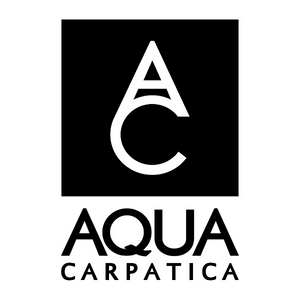It’s a long time to be working in the same job. Over dinner at one of the two restaurants at the San Felice resort, he explains: “As a winemaker doing consultancy, I could make double – maybe three times – the money. But first of all, I decided on a choice of lifestyle because if you do consultancy, you never stop working. I work enough – several Saturdays, some Sundays, and dinners. It’s fine – but if I did consultancy, it would become really too much for me. I prefer less money and more time.”
But the main reason he’s still in the same place after four decades is that San Felice is constantly evolving. The Tuscan wine estate has undergone a remarkable transformation during his tenure.
His main place of work – the historic Chianti Classico winery near Siena – has transformed (since 1991) from a largely abandoned medieval village into a luxury resort (below): a hotel with 28 rooms and 31 suites, and two restaurants – the Michelin-starred Poggio Rosso and the Osteria del Grigio (where we meet).
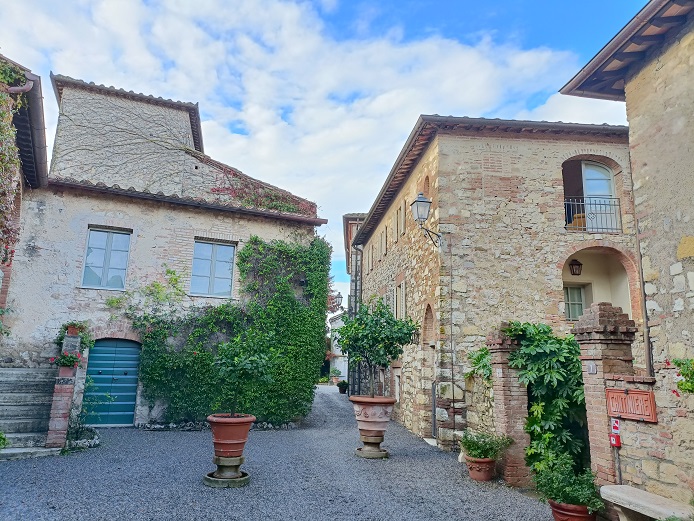
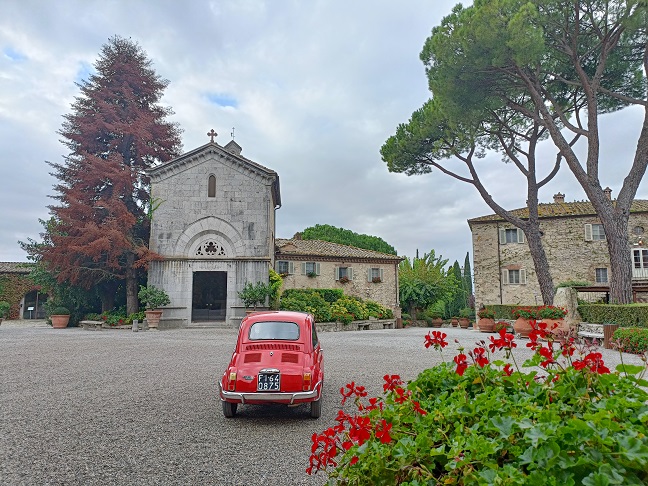
The wine side has also seen exciting changes: transforming from a traditional Chianti Classico producer to becoming a pioneer in viticultural research and sustainable practices.
The business, owned by the Allianz financial services group, has also expanded across three Tuscan terroirs, so Leonardo gets to make wine at:
- San Felice in Castelnuovo Berardenga (Chianti Classico)
- Campogiovanni in Montalcino (Brunello)
- And Tenuta Bell’Aja in Bolgheri.
In total, the estate spans 685ha – 188ha of which are vineyards (150ha in Chianti Classico, 23ha in Montalcino, and 15ha in Bolgheri). But I’m here because of one small plot. One of San Felice’s most significant contributions to Tuscan viticulture began shortly after Leonardo arrived. In 1987, in collaboration with the universities of Florence and Pisa, the estate established its Vitiarium (below): a 1.6ha experimental vineyard; a project dedicated to preserving and studying traditional local grape varieties at risk of extinction.
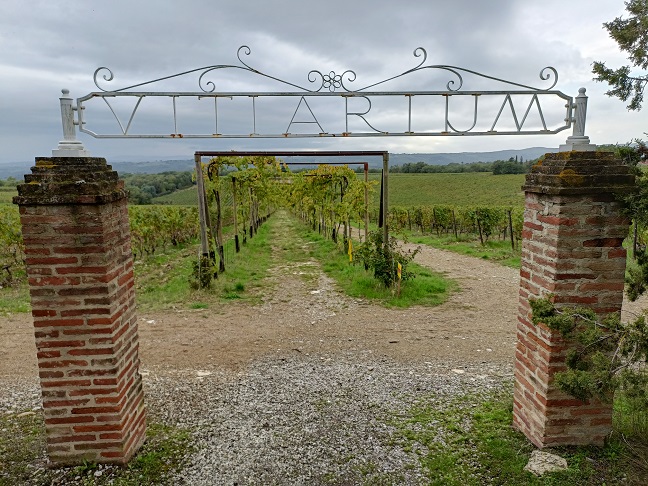
Among the 229 different varieties originally identified, 105 are now planted here (18 plants of each variety). From these, 30 of the most promising varieties underwent a second phase of experimentation – microvinifications during successive harvests.
But from the start of the project there was one grape variety that stood out: Pugnitello – an ancient variety originally from Maremma.

Its name means “little fist” in Italian – describing the small, compact bunches which probably contributed to the variety’s descendance into obscurity. Yields are extremely low. And it also ripens very late.
But this means it can retain acidity even at high alcohol levels (typically 14-14.5% ABV) and has thick skins, contributing to the deep colour of the wines.
Wines made from Pugnitello are often described as: rich and concentrated; well-structured with smooth tannins; aromatic, with notes of cinnamon, cedar, mixed berries, and tobacco; complex and age-worthy.
After the success of the first microvinifications, Pugnitello was grafted onto a thousand plants. The first three barrels of the wine (in 1995) were so “amazing” that the grape was then planted in 12ha – in four parcels most suited to it, becoming the estate’s second-most planted variety after Sangiovese (70% of plantings). They have also planted a few rows in Montelcino, filling two tonneaux this year. But Leonardo says: “I believe in Chianti it has more character.”
Its ascendancy was secured when it replaced Sangiovese in San Felice’s pioneering SuperTuscan, Vigorello.
Vigorello: a game-changing wine
In 1968, San Felice made a bold move that would set the tone for its future innovations. While other Chianti Classico producers were adhering to DOC regulations requiring at least 10% white grapes in their blends, San Felice chose a different path. They created Vigorello, a varietal Sangiovese that celebrated the site’s unique synergy between grape, soil, and climate. This premium-quality Vino da Tavola marked a significant shift in philosophy and helped to alter the face of Tuscan wine forever.Vigorello has since undergone massive changes. The last 100% Sangiovese version was the 1978 vintage – as 10% of Cabernet Sauvignon was introduced in 1979, increasing to 40% “year by year”. In 2001, Vigorello featured 15% Merlot too. When the Chianti Classico rules changed in 1995, allowing 100% Sangiovese, Leonardo began using Sangiovese for the Riserva (Il Grigio Chianti Classico Riserva DOCG) and then the Gran Selezione (the single-vineyard Poggio Rosso), and “to preserve our Tuscan character I substituted the Sangiovese with Pugnitello from the vintage 2011,” Leonardo (below) says.
Pugnitello is now the major grape in Vigorello at 35-40% of the blend.

The Vigorello Toscana IGT 2019, for example, has 35% Pugnitello, 30% Merlot, 30% Cabernet Sauvignon and 5% Petit Verdot. The winemaking involved:
- 20-25 days on skins, fermentation in oak at 30°C.
- MLF and 24 months’ maturation also in 225L French oak barriques.
- A further eight months of ageing in bottle before release.
As we taste the newest release – the 2021 vintage – Leonardo says: “One of the problems of Vigorello is people complain a little that I have changed the blend too many times. It started 100% Sangiovese in the 1960s, and then we introduced the Cab, then we introduced the Merlot, and then we took out the Sangiovese and replaced it with Pugnitello. But for each change there is an explanation.
“The first is because at the end of the 1970s, Cabernet became a historical new frontier of this area. After Tignanello succeeded, we started to use Cab and when I have replanted the vineyards knowing Sangiovese is a very demanding variety, I haven’t planted in the bottom of the valley if the exposure is not perfect. So, I have chosen other varieties. In some vineyards I have planted Malvasia Nera or Ciliegiolo. And mostly at the bottom of the valley I’ve planted Merlot, so after a few years – when the vines started to become mature – the result of the Merlot was nice, so I decided to use it in the blend. And finally, when we started to think about the Gran Selezione project (first released in 2010), I decided to use all the Sangiovese for our top Chianti Classico. But I wanted to keep the Tuscan blood – the Tuscan roots – in Vigorello so I used Pugnitello.
“It makes sense but if you don’t have the opportunity to explain, people think you are changing the label, changing the blend for no reason. The wine world is very classic.”
But it’s these changes and the constant evolution of the wines and estate that keep Leonardo rooted here.
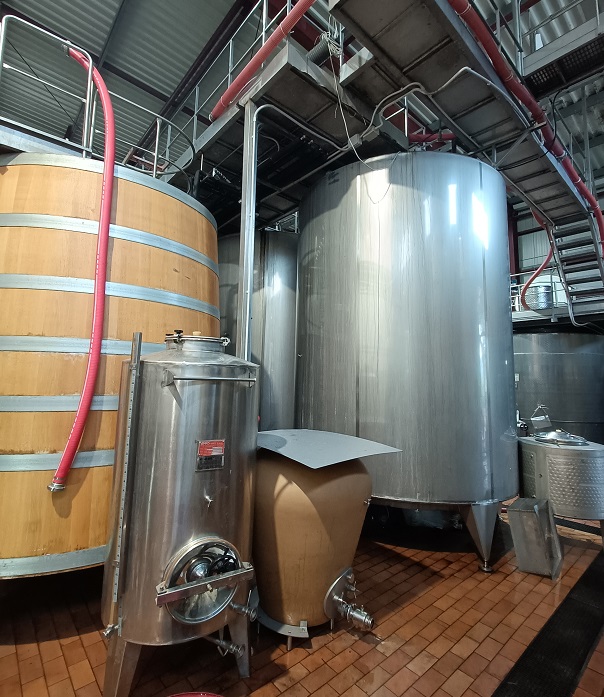
The latest experiment is introducing amphora to the winery for a special Pugnitello from the 2024 vintage. It’s for my growing portfolio of limited-edition wines featuring rare but wonderful grape varieties, like Kisi and Khikhvi from Georgia, Rumeni Plavec from Slovenia, Bakator from Ukraine, Pearl of Victoria from Hungary, and Muscaris from Austria.
The wine will be a blend of Pugnitello fermented in amphora, tonneaux and stainless-steel tanks, and aged in amphora and oak. This fermentation regime was inspired by my piwi project in Austria and they bought the 750L amphora from Tava (above) specially for my experimental Pugnitello.
Apart from the amphora, it’s classic winemaking, very similar to what’s done with the Sangiovese and other red varieties here.
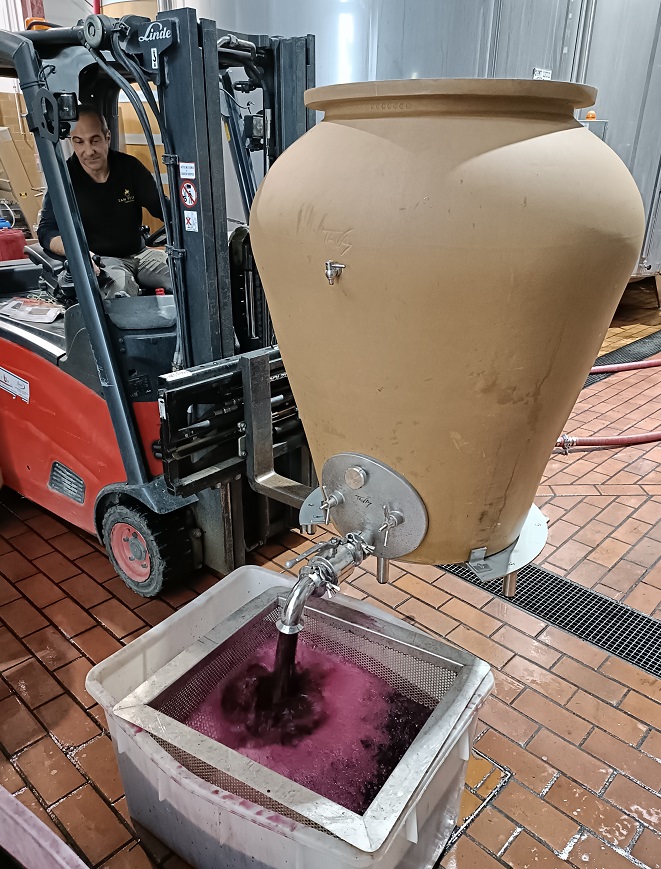
- Handpicked grapes, sorted, destemmed, crushed, went into a variety of fermenters (in this case two open tonneaux, the amphora, and a large stainless-steel tank).
- They were inoculated with a local yeast and fermented at a maximum 28°C (about 26°C in the tonneaux and amphora).
- 16-17 days’ maceration – slightly less than the more typical three weeks – with twice-daily punchdowns (once at weekends) for the amphora and tonneaux and pumpovers for the must in the tank.
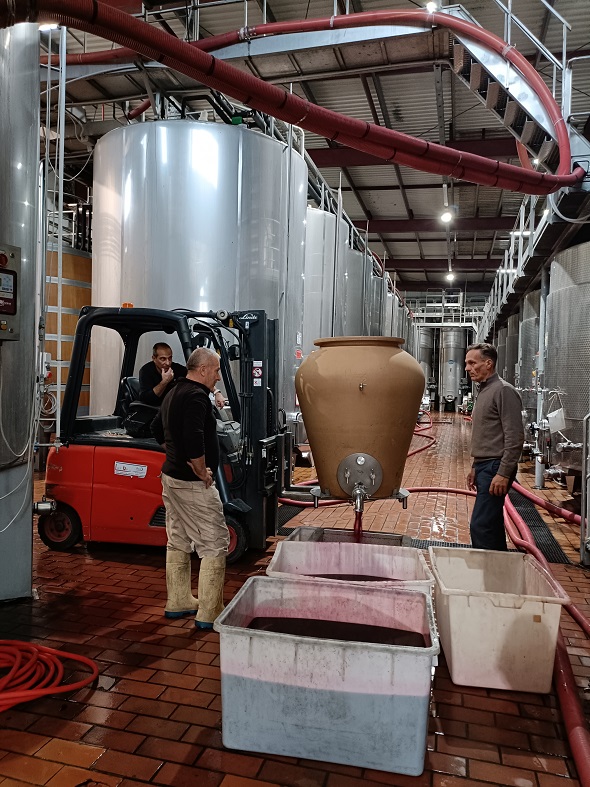
- The wine was run into plastic containers while the skins were taken to the press, so “the flower” – the free run – could be drained and returned to the original, cleaned vessels. The pressing went into a separate container for a lower-level wine.
- “The fermentation went through to the end easily,” Leonardo comments, “because the sugars were good but not super-ripe”.
- Malolactic will be allowed to happen naturally.
- After MLF, the wine will be sulphured and pumped to a mixture of clay, barriques, and tonneaux – 25-30% new wood – for a couple of years of ageing and natural settling, keeping an eye on the SO2 levels
- The plan is to have a light filtration before bottling with under 100mg/L – usually 85-90mg/L – total SO2 and about 25mg/L free SO2.
- The wine will spend an extra six months in bottle before releasing in 2027.
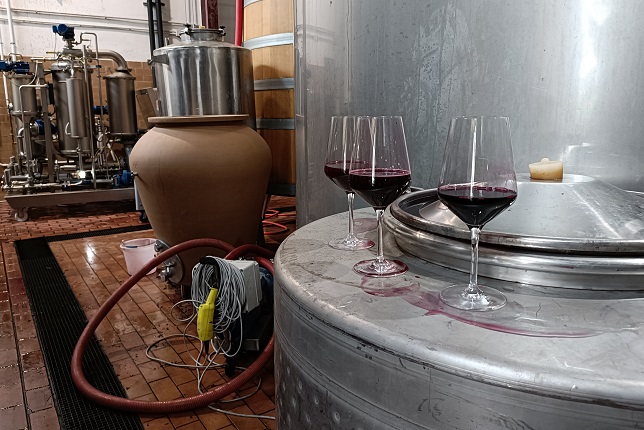
I taste and compare samples from the wood, clay and steel. There are subtle differences. The amphora is my least favourite as it is a bit reductive. But it’s still early days. This is the start of a long journey for the wine. Leonardo believes it has incredible ageing potential: “Easily 20 years. We tasted the 2006 recently and it was really beautiful. Unfortunately, I only have a few bottles of the very first (commercial) vintages – 2003 and 2004. But we have some 2007 and 2008 – all still in good shape.”
My focus returns to the 2021 wine. I comment that it’s still fruity after three years, including a couple of years in oak.
“One of the characteristics of Pugnitello – and this is really unique,” Leonardo reveals: “If you leave in the glass and you taste every ten minutes you have a different flavour in your mouth. The fruitiness in a young wine is definitely the first thing you taste but then you get spice, the earthiness, so it’s a wine that evolves both in the glass and in the bottle.”
I noticed this with three samples in the winery – how much they evolved from the first sip to after the wines had been racked and returned.
The other thing we chat about is how the late-ripening Pugnitello is ideal for the future here. “The grapes at the end keep good acidity,” Leonardo says. “The skins are ripe but not too exposed to the extra sun. And the result is a wine with fresh fruit on the nose, and in the mouth a good balance between volume and structure that is maintained alive by fresh acidity.”
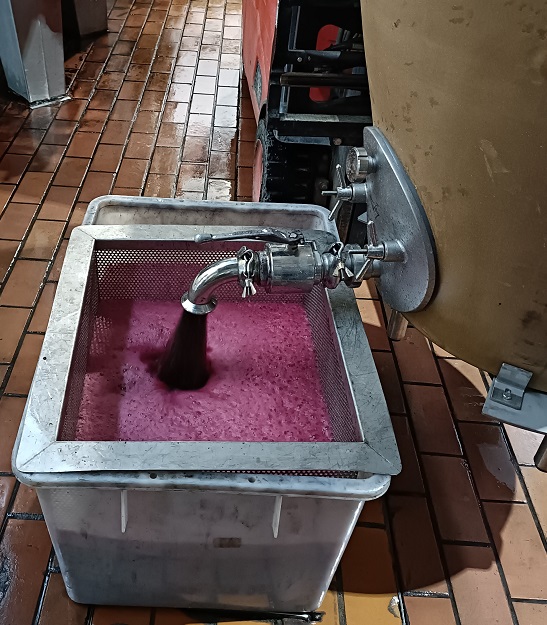
The other characteristic we comment on is the incredible colour. Leonardo points out: “It doesn’t change with ageing as much as Sangiovese or Nebbiolo. It’s very stable, especially the part aged in small oak. The small oak helps to keep the colour more because the tannins of the wood make a link with the anthocyanins, making it more molecularly stable.”
Leonardo admits he’s a fan of ageing in oak. “I think for a great red wine it needs to spend a little part of its time in wood in the cellar (below),” he states.
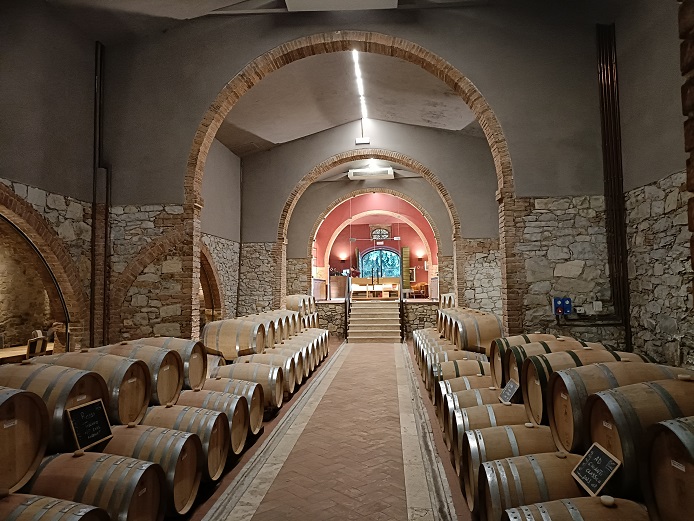
Fingerprint variety
Pugnitello is fast becoming the “fingerprint” variety for San Felice and now stars in its new line, called Vitiarium. The four new wines in the lineup are: Pugnitello Toscana IGT 2021, Borgo Chianti Classico DOCG 2022 (with 10% Pugnitello in the blend), La Pieve Chianti Classico DOCG Gran Selezione 2021 and In Avane Chardonnay Toscana IGT 2022.Pugnitello’s journey from near-extinction to rising star is a testament to the value of preserving indigenous grape varieties. While it may be premature to declare it the next big thing in Tuscany, its unique characteristics and the growing interest from both producers and consumers suggest a bright future. I certainly hope so!
What I like about this success story of a discarded variety rising from obscurity to starring role in a SuperTuscan is that it serves as a reminder of the hidden treasures that may still lie dormant in the world of wine, waiting to be rediscovered and appreciated anew.
Now that the wines are heading to the cellar for a long period of élévage, Leonardo can turn his attention to the next project: expanding the storage area and moving the bottling line while producing more than one million bottles of Chianti!

 English
English French
French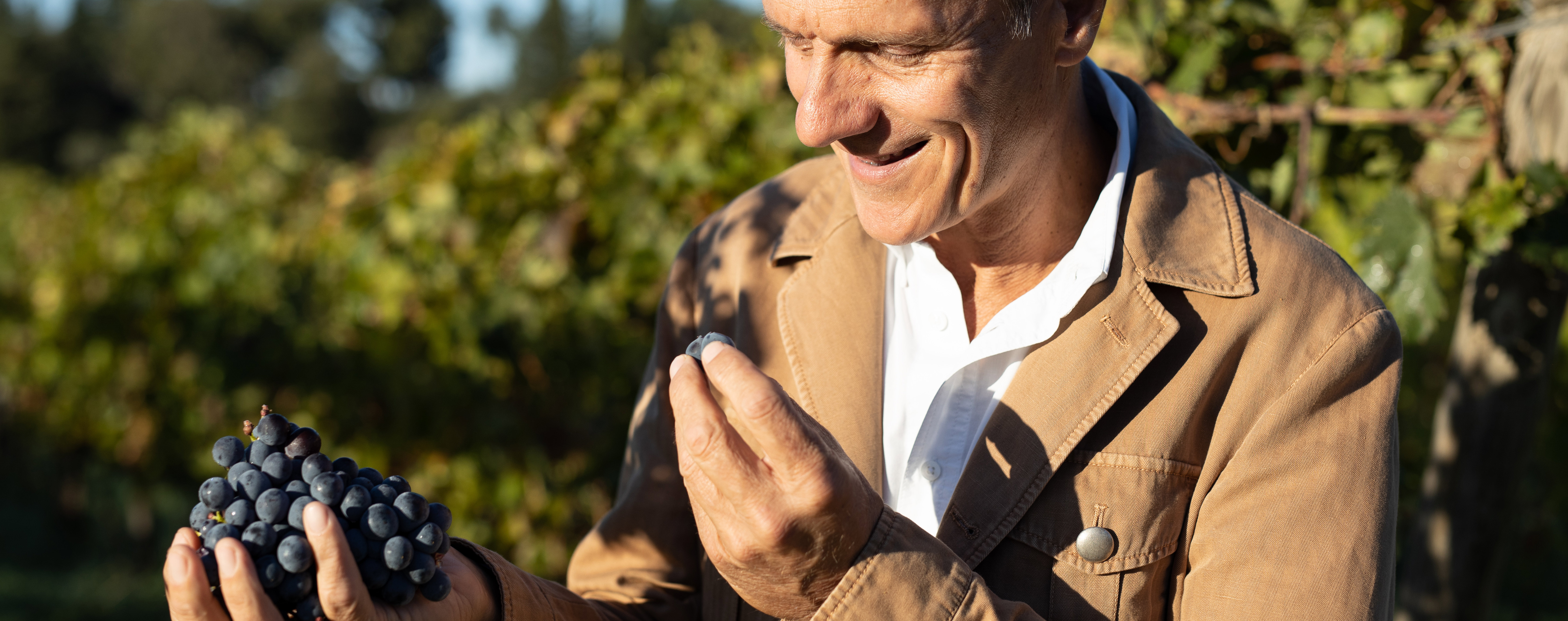



.png)


.png)



